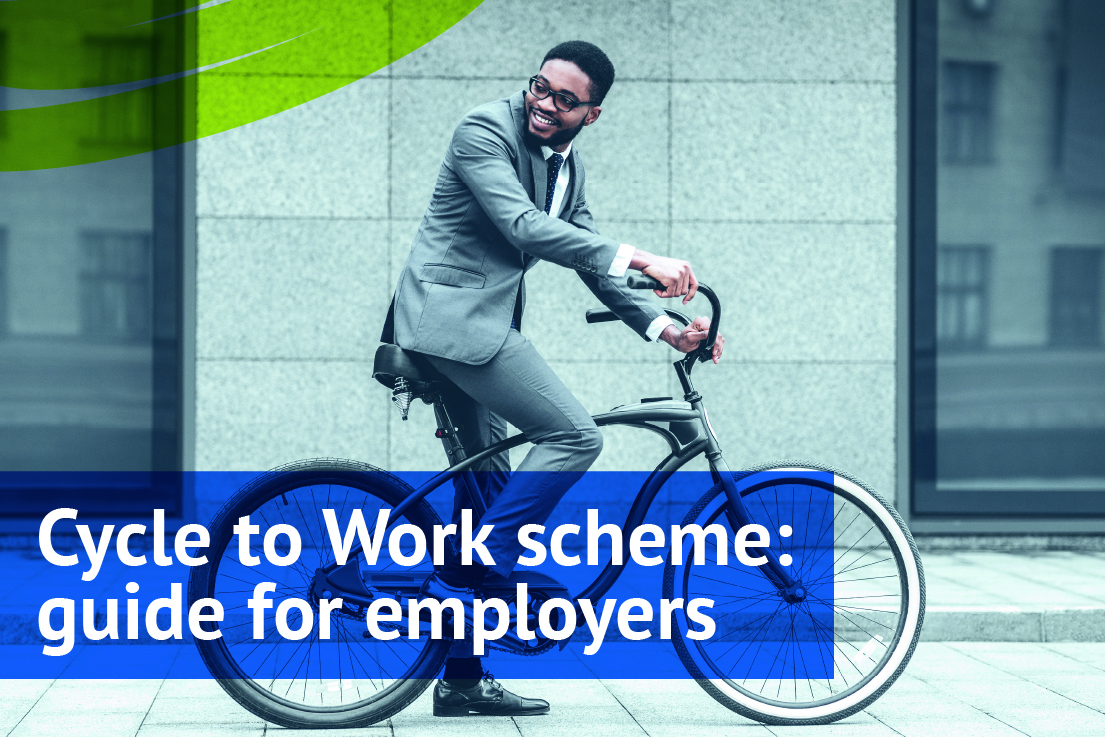Cycle to Work scheme: employer’s guide
25th August 2020
Last updated: 21st November 2022
Considering offering the Cycle to Work scheme to your employees? Read our Cycle to Work scheme employer’s guide.
It’s been reported that as many as 16% of the population, or 8.9million people, are now cycling every week, and the Government has earmarked extensive funding for cycling projects, including temporary pop-up cycle lanes and pavement widening designed to encourage more people to get on their bikes.
Cycle to Work is a salary sacrifice schemes that gives employers the option to loan bicycles and related equipment to employees as a tax-free benefit. It’s not a new scheme – it’s actually been in place since 1999 – however you may have heard more about it recently as a result of the COVID-19 pandemic.
What is the Cycle to Work scheme?
The Cycle to Work scheme is designed to help employees save money on the cost of a new bike for commuting.
Under the scheme, the employer covers the cost of a new bike and eligible associated equipment. The employee repays the employer via monthly tax-free instalments under a salary sacrifice arrangement. This means that employees pay less tax and National Insurance during the period they are repaying the bike and will eventually save a minimum of 32% of the actual cost of the bike as a basic rate taxpayer (and more for higher rate taxpayers).
At the end of the repayment period, employees have the option to buy the bike at a pre-defined Fair Market Value (FMV).
The scheme is simple to set up and use, requires little administration time and actually provides a small financial benefit to employers too, as they’ll save money on employer NICs.
How does it work?
Register with a provider
The first step as an employer is to register with a Cycle to Work scheme provider. There are many providers available, including most major UK bicycle shops such as Halfords and Evans Cycles. The role of the provider is to run the scheme on your behalf, help advertise the scheme to your employees and ensure the scheme is compliant with legislation.
Employee chooses their bike
Employees can choose their bike (and any related equipment) from the scheme provider. The selection available will be dependant on the provider and usually they have their own network to choose from.
Pay for the bike
You will pay for the bike and make it available for the employee to use under a “hire” agreement. Hire periods must be for a minimum of 12 months, however some providers also offer longer contracts.
Employee repays cost via monthly instalments
Monthly payments for the new bike are taken from the employee’s gross salary under a salary sacrifice arrangement. The monthly repayments should appear on their payslip as a deduction from earnings, usually alongside pension contributions, before any tax or National Insurance is calculated.
Because employees repay the cost of the bike pre-tax, they will effectively save money on the cost of the bike – 32% for basic rate taxpayers, 42% for higher rate taxpayers, and 47% for additional rate taxpayers.
After the hire period ends
Once the hire period ends, the employee has two options:
- Return the bike to the employer. The employer will then usually sell the bike back to the scheme provider and the employee is free to start the scheme again with a new bike if they wish.
- Buy the bike. The employee will purchase the bike from the employer at its FMV, as determined by HMRC in the table below:
| Age of cycle | Acceptable disposal value as a percentage of original price (including VAT) Original price of the cycle less than £500 | Acceptable disposal value as a percentage of original price (including VAT) Original price £500+ |
| 1 year | 18% | 25% |
| 18 months | 16% | 21% |
| 2 years | 13% | 17% |
| 3 years | 8% | 12% |
| 4 years | 3% | 7% |
| 5 years | Negligible | 2% |
| 6 years and over | Negligible | Negligible |
It’s important to remember that because this is a hire agreement and not a hire purchase agreement, any decision to sell the employee the bike/equipment at the end of the hire period must be entirely discretionary and not presented as an option in the hire agreement. This is because different regulatory rules apply to hire purchase agreements. Scheme providers will ensure any paperwork is correct and kept within regulatory requirements.
The employer can also simply gift the bike to the employee or sell it for less than FMV. If this happens, a taxable benefit arises equal to the difference between the FMV and amount paid. This must be reported on form P11D and will be subject to Class A employer-only NICs.
- Buy the bike later. Most scheme providers offer the option to pay a small deposit to re-hire the bike (typically 3-7% of the original value). After this period ends the bike is transferred to the employee for free. This is an attractive option for employees on shorter hire agreements as it avoids the potential 18% or 25% payment which eat in to the tax savings the employee has made.
How do employers benefit from the Cycle to Work scheme?
Aside from the obvious employee health and wellbeing benefits provided by the Cycle to Work scheme, employers will also see a small financial gain from operating the scheme.
This is because there is no reciprocal benefit charge as there is an income tax exemption on cycles and cycling equipment provided by employers for qualifying journeys (i.e. commuting from home to work). As an employer, you’ll save income and NICs via payroll without a corresponding charge for the benefit. You’ll save around 13% on the cost of the bike.
You can read more about this in the Government’s Cycle to Work scheme employer’s guide here.
Qualifying conditions for the Cycle to Work scheme
The scheme is open to all businesses and all employees qualify, provided they are over 16 and a UK taxpayer within the PAYE system, however there are a few qualifying conditions to bear in mind:
- Employees under the age of 18 must have a guarantor to participate in the scheme
- Earnings must remain above the level of National Minimum Wage after the salary sacrifice
- Self-employed people do not qualify for the scheme
- There is now no cost limit, however authorisation may be needed for bikes costing more than £1,000 due to Financial Conduct Authority (FCA) regulations. Your scheme provider will be able to advise on this
- The scheme extends to bikes with electric assistance, but not micro-scooters or motorbikes
- Employees are permitted to have more than one bike under the scheme, as well as any associated equipment, including: helmets, locks, repair/tool kits, lights/pumps/bells/bulb horns/mirrors and mudguards, reflective clothing, and luggage carriers and child seats
- There is no requirement for the employee to log their journeys and they are permitted to use the bike at any time, however at least 50% of journeys should be work-related. A work-related journey is any journey where at least part of it is commuting or travelling between workplaces. For example, if an employee cycles to a train station and then gets a train for the remainder of their journey to work, it is classed as a work-related journey
- If the employee’s employment ends before the end of the hire agreement, the remaining balance is to be deducted from their final net pay
Talk to the experts
Our Cycle to Work scheme employer’s guide covers everything you need to know about offering the scheme to your employees. Still have questions? Get in touch with our friendly team for further guidance and support.





